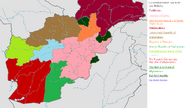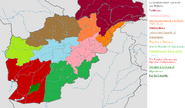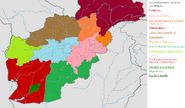Notice[]
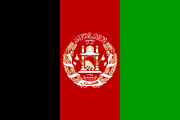
The post 2006 flag of Afghanistan.
Before editing, please read the Afghanistan's overview page to fully understand the complex, baffling, bazaar, oddball and weirdo ethnic, political, cultural and religious situation in the country!
Stats[]
Afghanistan (Persian/Pashto: افغانستان, Afġānistān) is an obscure and confused patchwork of warring local emirates, warlords, Islamic states, democratic republics and tribal entities. Tajikistan, has laid claim to some of its northern lands to.
History[]
Doomsday[]

A Pashtun Girl.

A scenic view of west, Afghanistan

Landscape_in_Paktia_Province.
Due to being a Persian, Pakistani and UK allied, Afghanistan was not spared by Doomsday. The capital city of Kabul was hit by 3 1kt, Mazar-e Sharif was hit by 1x 1kt and Kandahar was hit by 1 Soviet 2.5kt Soviet free fall bomb. Bagram AFB, Dasht-e-Kiligai, Shindand AFB were all hit by a NATO 15kt bomb. 3 1kt NATO free fall bombs hit Tajikistan, 1 1kt was dropped Dushanbe airfield, 1 1 kt hit Faknor, Shaka and Punj towns and 1 kt hit the passses near Faknor, Shaka and Punj. The Afghans and Tajiks were lucky a rather small nuclear attack compared to what places like Germany and Poland took. Without the Malik/Pasher (King) to keep control the rest of the country plunged into chaos. A cholera outbreak hit Kabul in mid-1962 and mid-1963. A severe famine and a cholera outbreak hit southern Tadjikistan, killing many people during 1963, 1965 and most of 1966.
Snow fall was unusually heavy in the Toba Kakar Mountains, Hindu Kush, Safed Khirs and on Mount Khumbur Khule Ghar during 1962 and unusually light in 1964.
Amidst the confusion, the Pashtun people of south eastern Afghanistan-who had long desired their own state-convened in the city of Lashkar Gah on January 29, 1964, and declared independence. The first year of the new nation's existence was focused mostly on survival and building up a functioning state. A year later, Hazaria left the nation of Afghanistan and then the Province of Herāt followed suit 2 days later, thus leading to the nation’s utter disintegration on ethnic lines.
Agricultural output rose slightly in the east of the country due to the increased vigour, better irrigation systems and improved water distribution around the Rivers Gomal, Kunar, Alingar (also Alingâr), Kabul and Logar in the east of the country, during the late 1960’s. A new water driven saw mill was opened in Jalalabad.
Post-Doomsday[]
The leadership of Pakistan’s more radical Islamic groups, soon migrated to Eastern Pashtunistan and parts of Afghanistan in 1964-65, renaming it The Islamic Republic of Afghanistan after taking the area over in 1967. They remained in power as The Islamic republic of Afghanistan's hastening the end of Afghanistan. Under Mullah Ali Anwar’s post-Afghan rule he styled himself as a promoter of traditional Muslim and Pashtun culture (calling himself "The leader of the Pashtun people"), but he became notorious in Central Asia and the Middle East for his dictatorial rule and extravagant cult of personality.
The Democratic republic of Afghanistan and Democratic Republic of North Afghanistan came in to exsistance in mid 1967.
The Slavic dominated ex-Soviet regime in Tadjikistan was in trouble to, but communist zeal would hold out against the Islamists until the late 1970's. Badakhshan Province was annexed in 1967. They then invaded and annexed parts of northern Afghanistan in 1977 and 1982.
The nation beaks up compleattly[]

Afghanistan in 1965.
All the provinces were torn apart by a bloody civil war amongst the new nations as the josstled for territory between 1967 and 1978. Tadjikistan would also invde it from early on in the conflict.
.
By 1967, the basic, core territory of the new nations created was-[]
| Nation. | Provinces held. | Regime. | Founding cause. | Founded in. |
|---|---|---|---|---|
| Tajikistan | Tajikistan. the Wakhan Corridor and Wakhjir Pass in Badakhshan Province were annexed in 1967. | Communist until 1983, Islamic from 1983 to 1985 and democratic thereafter. | Local Polit-buro staged a post-war coup. | 1963 |
| Democratic Republic of North Afghanistan | Badakhshan_Province , Kunduz_Province , Kapisa_Province , Baghlan_Province and Takhar_Province. It was annexed by Tajikistan from 1977 to 1984. | Democratic republic. | Political and ethnic issues. | 1967-1977. 1984. |
| Hazaria | Bamyan_Province , Panjahir, Ghor_Province and Daykundi_Province. | Republic | Ethnic issues | 1965 |
| Republic of Kabul | Kabul_Province , Laghman_Province , Nangarhar_Province , Kapisa_Province , Logar_Province Logar , Panjshir_Province Panjshir , Parvan_Province Parvan and Vardak_Province Wardak . | Democratic republic (communist between1982 and1992) | Political resons | 1967 |
| The Republic of Nuristan | Nurestan_Province and Konar_Province. | Democratic republic | ethnic and Political resons. | 1978 |
| Herāt Emirate | Herat_Province Herat and Farah_Province Farah . | Islamic Emirate | Religious and ethnic issues. | 1965 |
| Pashtunistan | Ghazni_Province Ghazni Farah_Province , Kandahar_Province Kandahar Farah_Province , Oruzgan_Province Oruzgan Farah_Province , Paktia_Province Paktia Farah_Province , Paktika_Province Paktika Farah_Province , Logar_Province Logar , Kapisa_Province Kapisa Farah_Province . Farah , Zabol_Province Zabol , Helmand_Province Helmand and Nimruz_Province Nimruz . | Islamic Reublic | Ethnic issues. | 1964 |
| The Islamic Republic of Afghanistan | Ghazni_Province Ghazni , Kandahar_Province Kandahar , Oruzgan_Province Oruzgan , Paktia_Province Paktia , Paktika_Province Paktika , Logar_Province Logar and Kapisa_Province Kapisa . | Islamic Republic | Religious issues. | 1967 |
| Democratic republic of Afghanistan | Samangan_Province Samangan, Sare_Pol_Province Sare Pol, Balkh_Province Balkh , Faryab_Province Faryab , Jowzjan_Province Jowzjan , Kapisa_Province Kapisa and Panjshir_Province Panjshir . | Democratic republic | Political and ethnic issues. | 1967 |
| People's Democratic Republic of Afghanistan. | Paktia_Province Paktia , Logar_Province Logar and Ghazni_Province Ghazni . | Communist, Pro-Tajikistan. | Bevelled Tajikistan/ communism was good and thus left the IRA. It finaly merge with Kabul. | 1977- 1992. |
| Unaligned local warlords, mullahs and tribal elders. | Badghis_Province Badghis , Baghlan_Province Baghlan , Wakhan Corridor, Wakhjir Pass, Kapisa_Province Kapisa , Khost_Province Khost , Logar_Province Logar , Konar_Province Konar , Zabol_Province Zabol and Panjshir_Province Panjshir . | Varied | Varied | 1967-1979 |
1st Civil war[]

Afghanistan in 1967.
All the provinces were torn apart by a bloody civil war amongst the new nations as the josstled for territory between 1967 and 1978.
Balochi tribal elders and local Mulahs set up the Balochi Islamic Republic in the Chahar Burjak, Chakhansur and Zaranj dfistricts of Nimuz province1979, untill it was democraticly intergrated in to Peshtunistan in 1982. Mohammed Daoud Khan staged a republican coup in The Karbul republic during 1973. He tryed to keep Nuristan and Hazaria in the union. Hazaria was not intrested and Nuristan left in 1978. In order to increase domestic pashtun support, he took a stronger line on the Pashtunistan issue and promoted a proxy war in Pakistan's rebellious Waziristan and NWF regions. Trade and transit agreements with Pakistan where subsequently severely affected.
Unaligned local warlords, mullahs and tribal elders of Badghis, Baghlan, Kapisa, Khost, Logar, Konar, Zabol and Panjshir were defeated in 1979 by the IRA. They all wnt to the IRA, exept Baglan which joined the DRNA, Badghis which remained indipendent untill 1987 (when it joined the DRA) and Logar which was part of the PDRA since the cpoup of 1977.
The PDRA was formed when Paktia and Logar Provinces joined forces with the Communist Tajik invasion in 1977 and 1982. The bulk of the Tajik people also wanted to be united and the rulers wanted to promote Communism.
Communist/Democacy/Islamist/ethnic/Shi'ite/Sunni split would tare the nation appart. The War would also briefly reignite in the late 1990's and mid 2000’s due to the Taliban.
The Swat Valley[]
The 1974 Hunza earthquake devistated the Swat Valley in the the ex-Pakistani province of Swat (Urdu: ریاست سوات), which had beecome the Islamic republic of Swat in 1972. Sikh refugees flead from the Swat Valley to Kabul after the secterian riots of in 1992-98. A slow trickle Moslem immigrants have from the Swat vally to the Islamic Republic of Afghanistan ever since 1965.
People's Democratic Republic of Afghanistan.[]

Dr Mohammad Najibullah.

The PDRA's flag.
Paktia, Ghazni and Logar Provinces rebelled against the IRA, under thier new Communist leder, Dr Mohammad Najibullah Ahmadzai in 1977. A Marxist coup was encorged in the Repubic of Kabul and the Kapisa province of the IRA, which were fully Bolshivised by 1979. The first communist leaders in Afghanistan were Dr Mohammad Najibullah, Nur Muhammad Taraki, Babrak Karmal and Hafizullah Amin. As time passed Hazaria and the IRA would graduly fall to local communist isergents.
Mulavi Younas Khalis split with Gulbuddin Hekmatyar in 1979 and established his own Hezbi Islami, known as the Khalis faction, with its power base in Nangarhar and a few patches of Helmand and Panshir provinces. He was eventuly subdued, but not fully defeated in 1986.
Irrigation was improved, farming enharnced, water driven wood-cutting machnary was intoduced and women's rights upheld in the People's Democratic Republic of Afghanistan during the 1980's. Agricultural output rose slightly in the east of the country due to the increased communist vigour, better irrigation systems and improved water distribution around the River Logar in the east of the country, during the late 1980’s. Northern Kandahar and Helmand provinces were occupied by the communists from 1982 to 1992. Haji Bashir Noorzai, a leader of the Noorzai tribe, fought the Communists in the north of the Kandahar province, and near Girishk town in Helmand province. Gulbuddin Hekmatyar faught them in Kapisa province during the 1980's.
Mullah Ali Anwar’s son Hammed became the "leader of the Pashtun people" in The Islamic republic of Afghanistan in 1982 and continued the dictatorial rule and extravagant cult of personality. The extent of his son’s power over the region greatly increased during the early 1990s, and more so in 1999, after inherited the leadership in 1982 and became President for Life. Dr Mohammad Najibullah did not like the cult of personality and prefured rule by fear.
Harakat-i-Inqilab-i-Islami (Islamic Revolution Movement) was a traditionalist Afghan mujahedeen group fighting in Kandahar, Helmand, Uruzgan, Ghazni, Paktika, and Wardak fom 1984 to 1999. Mohammad Nabi Mohammadi was the only major leader of the group (1984-2001). At his meetings he practised and was protected under "Melmastia", the Pashtun code of hospitality, so invited guest can be harmed. Harakat-e-Inqilab-i-Islam,which was founded by Mohammad Nabi Mohammadi. The party was moderate Islamic group, slightly radicalising over the years, but was a major foe of Gulbuddin Hekmatyar’s Islamic malitia.
Dr Najibullah's Communists, worked at destroying Dr Abul Haq’s democratic urban resitance between organization, which he had crushed by early 1987. He left Afghanistan to build a trading business in Dubai in 1992.
At the end of 1987, Najibullah called for a 1 year ceasefire and talks between the various opposition factions, as part of his policy of national reconciliation. The discussions, which would have led to the establishment of a coalition government and be the end of the PDPA's monopoly on power. The programme failed outside of Nuristan, but the government was able to recruit disillusioned DRA, DRNA and IRA fighters as government militas.
In the areas under his control Ahmad Shah Massoud he set up democratic institutions and signed the Women's Rights Declaration in 1988. General Abdul Rashid Dostum did so a year later.
Eventually communism would fall and the PDRA would be democatised in 1992 and join Kabul.
2nd Civil war[]

The 1987-1992 flag.

The flag of Islamic Party of Afghanistan, jihadist group led by Gulbuddin Hekmatyar.
When the People's Democratic Party of Afghanistan collapsed and the PDRA fell, the IRA, RNA and DRNA fought it out with each other, Kabul and the Hazara from 1992 to 1995 in a pointless ego-derived terf war. Persian forces would set up a occupied buffer zone in the south of the more peacable Nimruz Province in early 1996, but would be involved in fighting in Helmand and northern Nimuz by late 1997.
During the early 1990s the Harakat-i-Inqilab-i-Islami group fell into political decay and membership colapsed as most of it’s members, including the spiritual leader of the Taliban Mohammed Omar defected to the Taliban in 1992. Hezbe-Islami saw some losses to the Taliban to. Dr Ali Niyazov and Hammed Anwar were regularly fighting allies of Gulbuddin Hekmatyar’s Islamists in their lands during 1994 and 1995
Local chieftain Gul Agha Shirzai of the Barakzai tribe took over nearby Kandahar town between 1992 and 1995. His regime extorted bribes at checkpoints, sold protection to a local opium trafficker, gave all the jobs to his Barakzai tribesmen, embezzled money, ran protection rackets used his time in power to benefit himself and his tribe at every one else’s expense. Other tribes in Kandahar complained Shirzai was unfair and his abuse of power would turn the locals in to Taliban and IRA supporters. He was killed by the Taliban and the town was taken over in the March of 1995.
When Ismail Khan officaly became the new Emir of Herat in mid 1993, exercised great wisdom and for-tough, provided rudimentary social welfare the Heratis, developed agriculture around the River Hari, expanded his political power into neighbouring provinces, engorged increased literacy amongst his people and largely maintained law and order.
The rebellious Gulbuddin Hekmatyar’s Hezbe-Islami Islamic malitia took over Pitika and Kunduz province between 1993 and 2003, then Nuristan between 1995 and 2004. Harakat-e-Inqilab-i-Islam,which was founded by Mohammad Nabi Mohammadi. The party was moderate Islamic group, but slightly radicalised over the years, but was a major foe of Gulbuddin Hekmatyar’s Islamic malitia.
The National and Islamic Prosperity Party of Afghanistan was formed by Maulawi Muhammad Osman Salekzada, in 1994 and got most of Harakat-i-Inqilab-i-Islami following in northern Afghanistan, especialy in Kunduz province and the district of Sar-e Pol District in Sar-e Pol Province, which the were in cotrole of during most1996, prior to the Taliband victory of January 1997. Harakat-i-Inqilab-i-Islami's Gen Ali Abdullah Turkmenie, Herat’s Abdul Majid Rouzi and one of Gen Dostum's deputies, Abdul Malik Pahlawan, then defected to the Taliban in late 1997.
The rise of the Taliban[]

The flag of the Taliban.

A Taliban religious police man beating a woman in public because she had remove her burqa in public.

A anti-Taliban Tajik special opps team in Badakhshan Province during 1997.
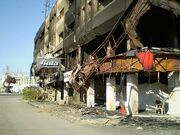
Burning shops in Kanahar in 1993.

A 1997 anti-Taliban raid by Kabul forces in Kandahar.
Gulbuddin Hekmatyar’s Islamic took over Pitika and Kunduz province between 1993 and 2003, then Nuristan between 1995 and 2004. They aided the Taliban’s northern operations against the DRNA and Tadjikistan. He was later defeated and nearly killed in combat DRNA forces in Kunduz city.
Dr Ali Niyazov and Hammed Anwar were regularly fighting allies of Gulbuddin Hekmatyar’s Islamists in their lands during 1994 and 1995.
The Taliban took over the Kandahar town of Jucilay in 1994. The Taliban started shelling Kabul and Herat in early 1995, but were defeated by forces of the DRNA and Karbul forces under Ahmad Shah Massoud. Spreading from Kandahar, the Taliban eventually seized Kabul in 1996. A series of Pashtun and Waziri suicide bombers devastated the armed forces of the DRA, IRA, Kabul and the DRNA between 1995 and 1996.The Islamic Emirate of Afghanistan was set up in the end of 1996, but had to face 3 sucsesfull suacide bombings by IRA agents in it's capitol in the march of 1997.
The local drugs cartels, which were first formulated in 1972, took over the provinces of Laghman, Logar, Kandahar, Bamyanand, Nangarhar provinces between 1995 and 1997. The opium output to Iran, Pakistan and Tajikistan was breath taking huge. The Taliban and the DRNA evenly crushed the narco-lords after much heavy fighting, especially around the River Logar.
The Taliban forces seized the Iranian consulate in Mazari Sharif and executed Iranian diplomats in 1998. Following this incident, Iran went war with the Taliban regions of Afghanistan and secured Nimruz and reinforced Herat's Emirate. Following the Taliban's harsh and unjust treatment of Afghanistan's Shia minority, Iran stepped up assistance to the Emirate of Herat and Pashtunistan. Iranian troops also helped secure the border of the ethnicly Persian and religosly Shi’ite Emirate of Herāt in 1997.
Hazara organized militias to defend themselves in Kabul and Mazar-e-Sharif, during 1995. When Mullah Omar’s Taliban thugs captured Kabul in 1996, he encountered a Hazara militia under the command of Abdul Ali Mazari. The met with the Taliban to negotiate, but Abdul Ali Mazari and was almost murdered as a heretic, but managed to escape with the help of a local warlord and a couple of friendly Balochi tribal elders. The hatred between the Taliban and the Hazara became obsessive, as Mullah Omar personally organised the Taliban ethnic cleansing campaign in Bamian, but were crushed when they tried to take took the northern city of Mazar-e-Sharif in 1997, but eventually they lost and were wiped out by the Taliban. When the Taliban forces seized the Iranian consulate in Mazari Sharif and executed Iranian diplomats in 1998. Following this incident, Iran went to war with the Taliban regions of Afghanistan and secured Nimruz and reinforced friendly Herat.
A earthquake at Takhar, which measured 7.5 on the Richter scale killed just over 2,000 in early 1999 thousand people. A violent aftershave killed 5,000 and collapses damaged buildings in the town and causes further across the town. The Taliban said it was an act of god and was to punish the rebel town.
The Taliban took control of most of Peshtunistan and the IRA in early 2000, under Mullah Mohammed Omar, after much street protesting in 1999 in both nations and the Lashkar Gah food riots of March 2000. Pro-Islamist rallies also occered in Sar-e Pol Province, Urozgan Province, Samangan Province, Parwan Province and Nimurz Province later that month.
By the end of 2001, the Taliban were had capture 90% of the country and safely run it aside from the opposition strongholds primarily found in the northeast corner of Badakhshan Province and around Herat.
The Taliban was a Islamic fundamentalist politico-religious movement composed of Pashtuns students in the Helmand and Kandahar region of Afghanistan. They blended local Pashtunwali tribal code with elements of Deobandi Islamic teaching to form a hard-line, uncompromising, anti-Western, anti-modern life and highly restrictive Islamic fundamentalist ideology with which it ruled.
Those who resisted were punished instantly, because the Taliban sought to impose a strict interpretation of Islamic Sharia law Women were banned from jobs, girls forbidden to attend schools or universities, banning kites, banning music, all men had have big, bushy beards; banning photos or drawings of people, banning whistling, banning 'sorcery', boozers were flogged and murders were hung. Communists were systematically eradicated and thieves were punished by amputating one of their hands or feet. Meanwhile, the Taliban managed to nearly eradicate the majority of the opium production by 2001. The people IRA, DRNA and DRA loath this pro-Islamic fudamentalist change.
At the time of Taliban Nahri Saraj District was under control of the less conservative Noorzai tribe. They were finally defeated and exiled to Peshtunestan in 2001.
3rd Civil war[]

Afghanistan in 2002.

Afghanistan in 2006.

Afghanistan in 2012.
General Mohammed Daud Daud, the Karbul Deputy Minister of the Interior for Counter Narcotics in Afghanistan before he was nearly killed by local drug lords in Takhar and Helmand province during 1999.
Islamist Mullah Dadullah, took over most of Helmand in 2000, but was forced in to the south of the province by Persian forces in late 2001. After the suspiciose death of its leader, Mohammed Nabi Mohamadi, in Pakistan in 2001, the leadership of the Harakat-i-Inqilab-i-Islami movement was taken over by his son Ahmad Nabi Muhammadi.
The United Front was formed to fight the Taiband. It included beside the dominantly Tajik forces of Massoud and the Uzbek forces of Dostum, the Islamic Republic of Afghanistan forces lead by General Ali Kamel, Peshtunistan forces led by Colonel Kamel Omar, Hazara factions under the command of leaders such as Haji Mohammad Mohaqiq and Pashtun forces under the leadership of commanders such as Abdul Haq or Haji Abdul Qadir in 2001. Everyone united behind the Tajiks, Uzbeks, Ahmad Shah Massoud and General Abdul Rashid Dostum; thus crushing the Taliband and their Pakistani cronies for good in 2001.
Nuristan annexed Konar in 2005 and the Taliban make a temporary resurgence Kandahar, Paktia, Paktika, Khost, Nangarhar, Parvan, Kapisa, Helmand, Zabol and Ghazni provinces in most of 2006. Following Mulavi Younas Khalis' death in mid 2006 the Khalis faction imploded. This saw heavy fighting in around the river Helmanbd and in both Panjshir and Parvan provinces as Iran reduced its forces stationed in Nimruz heavily and put the rest them under the command of Peshtunesan’s worryed government. Baghlan was reinforced by Tajik troops in late 2006 shortly after Mullah Omar hand picked Helmand’s Mullah Dadullah to lead the new terror campaign in Hazaria in 2006.
Dr Ali Niyazov, the founder of Peshtunistan, died of pneumonia, aged 68, on 27 October 2006, leaving no heir apparent and an unclear line of succession, so his loyal deputy Gen. Abullah Saddar took over and set about securing the nation's 1967 borders and developing agriculture.
Mullah Dadullah his 200 man suicide bomber force badly distablelised Haziria, the DRA and Herat. In a campaign ian early 2007 against Ismail Khan, Dadullah stepped on a land mine and retired with his artificial leg in 2009.
Tajikistan and Uzbekistan helped defeat most of them by mid-2007. Tajikistan temporally occupied a section of Baltistan bounded by Mt Nowshak and the towns of Mastuj, Chitral and Drosh, but give it to Nuristan after it had been pacified in 2008. Nuristan gave it back to the Council of Tribal Elders of the Baltistan in 2009.
Uzbekistan also helped crush the Taliban and Waziri forces in the nearby ex-Pakistani province of Waziristan between 2006 and 2007. Paktia, Khost and Paktika provinces still have some Uzbeck peacekeepers in it so as to supress local Waziri tribal radicals. Turkmenistan has helped stabelize the Swat Valley.
Since the people of Takhar took their violent revenge on Pashtuns for the crimes the Pashtun dominated Taliban did to non-Pashtuns, the number of Pashtuns decreased heavily in the provinces of the DRNA and the DRA.
Hamid Karzai[]

A notice from the 2007 elections.

The 2012 Afghan unity lobby's flag.
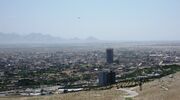
Herat City in 2009.
Hamid Karzai emerged as a unifying figure in 2002 and won the first unifyed election on 12 Febuary 2004 with a result of 78% on a turn out of 85%. Uzbekistan and Persia gave some alcahol and petrol driven Jeeps, 4x4 cars and trucks, as well as lost of samll arms, mortars and rocket launcers, to all the Aghan nations to help them final crush the last few drug lords, bandits and Taliban later that year. Afghanistan joined the 1997 Kara-kalpak, Kazakh, Kyrgyz, Tajik, Turkmen and Uzbek Alliance in 2003.
In an election on 11 February 2007, Hamid Karzai was elected president for a second term with 89% of the vote and 95% turnout, although the election was condemned by outside observers as "noticeably unfair". He was sworn in on 14 February 2007.
On September 27, 2009, Ismail Khan survived a suicide blast that killed 4 of his bodyguards in Herat, as he was driving to Herat Airport The powerful explosion occurred on the way there. A few days later, the Taliban spokesman, Zabiullah Mujahid, claimed responsibility and said the target was Mr Khan.
Most of the Taliban members surrendered in late 2009 and early 2010 after a series of heavy assaults by Tajik forces. A new Kabul city, Kunduz town and Herat town hospitals was built with Uzbek and Pakistani aid in the December of 2009. Nuristan re-joined Kabul in early 2010 and Herat joined the DRA in late 2010. Ismail Khan was almost forced to give up his rule in Herat, but was finaly allowed autonomy with in the DRA.
Tajik and Uzbek engineers have been rebuilding some of the major bridges through out the Kabul Republic, the IRA, the NRNA and the DRA, despite of the occasional.
Today, politics is still dominated by the conservative Islamic clergy and diehard warlords, who Hamid Karzai and his loya jirga (grand assembly) dislike. Mr Massoud and Gen. Dostum support him. The Talibnd and many of the hard line clerics still hold out around the town of Jucilay.
Regional terrorist groups such as the Haqqani Network and Hezbi Islami are actively involved in a nationwide Taliban-led insurgency, in which about 25,000 Afghans have died since 2003. Peace is maintained in most places by a 5,000 strong mixture of Indian, Persian, Turkmen, Uzbek, Pakistani and Tadjik forces. A combined force of 5,000 Chines and 1,075 Europa Alliance members (200 Neo-Romans, 400 Northern and Southern French, 200 Ankarans, 150 Irish, and 125 Izmiris) also operate in Kabul.
On 11 June 2012, 2 earthquakes struck northern Afghanistan, causing a large landslide, which buried the town of Sayi Hazara, trapping 71 people and injuring 8.
Maps[]
Weapons[]
- These weapons are known to be endemic in the country-
- Makarov pistol
- RPG-7 rocket launcher
- M1938 mortar
- The TT-30 (Russian: 7,62-мм самозарядный пистолет Токарева образца 1930 года, 7,62 mm Samozaryadnyj Pistolet Tokareva obraztsa 1930 goda, "7.62 mm Tokarev self-loading pistol model 1930")
- The DShK 1938 machine gun
- AK-47 assault rifle
- Colt M911 (side arm)
- Thompson Sub-machine gun
- 82-PM 41 Medium Mortar
- PPSh-41 machine gun
- The M116 75mm Pack Howitzer M1
- Stokes mortar
- Enfield No. 2 Mk I Revolver
- The Rifle, Anti-Tank, .55in, Boys commonly known as the "Boys Anti-tank Rifle" (or incorrectly "Boyes", nicknamed the "elephant gun")
- Austen submachine gun
- Short Magazine Lee-Enfield Mk I (1903)
Former refugee camps[]
- Karbul #1
- Karbul #2
- Karbul #3
- Karbul #4
- Kabul #5
- Herāt
- Abdul
- Ruksana
- Shazia #1
- Shazia #2
- Shazia #3
- Ashrat
- Ishrat
- Kalsoom
- Muktar
- Zada
- Narzia
- Assia
- Mepem
- Iqubal
- Kandahar
- Lash Nagar
Health issues[]
After Doomsday, most of Afghanistan found it hard to import medicine. The shortage of medical supplies resulted in the government making the controversial decision to legalize medical khat and marijuana in 1966. Even though, this choice led to an initial small increases in khat and marijuana smoking, opium usage and other crimes, the government believed the pros of the medical marijuana act outweigh the cons. This was revoked in 1978, because, in the long term, it had caused a generation of drug addicts to occur.
A cholera outbreak hit Kabul in mid-1962 and mid-1963. 10% of all women went permanently bald due to radiation sickness and skin and lung cancer were once common near Kandahar and Kabul. Thyroid cancer stopped being a problem in 1967.
A new Kabul city, Kunduz town and Herat town hospitals was built with Uzbek and Pakistani aid in 2009.
Economics, Infrastructure and Transport[]

Smoke from early morning fires linger over wheat fields in Khas Oruzgan district, eastern Uruzgan province, June 20th, 2007.

A bombed out school in the DRNA.
Transport is by horse, pack-mule, bicycle and camel-train. Uzbek mad and fuelled petrol-vehicles are minimal in number.
Most rural building, water works, sewerage plans, factories and bridges still lye in ruins, but the major towns and cities are less badly affected. Some Pakistani, Uzbek and Tajik supported reconstruction work has occered in non-Taliban areas since 2009, but most aid had been focused on the main towns and cities unill 2011.
The economy is agricultural by nature, with some opium poppy production still covering in places. The Kabul Republic, the IRA and the DRA are the most advanced regions; with Kabul province, Jalalabad, Takhar, Lashkar Gah, Kandahar, Herat, Mazar-e-Sharif and the Logar River valley containing about 65% of the nation's low grade industry.
Agricultural rose noticeably since the mid 1990's in the east of the country due to the increased locals' vigour, better irrigation systems and improved water distribution around the Rivers Gomal, Kunar, Alingar (also Alingâr), Kabul and Logar in the east of the country, during the late 1960’s and the late 1980's.
Some damage still remains from the both 1999 and 2001 Takhar eathquakes. and the 2012 Sayi Hazara eathquake.
Images[]
The regions and Rogue Nations[]
Democratic Republic of Afghanistan.[]
Democratic Republic of Afghanistan is a lawless region in Southern Asia, formerly controlled by the Democratic Republic of Afghanistan. The Tadjikistan invaded Afghanistan in 1977 and 1982 and annexed the DRA in 1984. Herāt Emirate, became an autonomous region in the DRA in 2010.
Democratic Republic of North Afghanistan[]
Democratic Republic of North Afghanistan.is a lawless region in Southern Asia, formerly controlled by the Democratic Republic of Afghanistan. The Tadjikistan invaded Afghanistan in 1977 and 1982 and attacked the new nation. The DRNA is now bordered by Pakistan in the south and east, Tadjikistan and Uyghuristan in the far northeast.
The Islamic Emirate of Afghanistan[]
The Islamic Emirate of Afghanistan (Pashto: د افغانستان اسلامي امارات, Da Afghanistan Islami Amarat), was founded in 1995 when the Taliban began their rule of Afghanistan and ended with their fall from power in 2001. Even at the peak of their influence, the Taliban never controlled the entire area of Afghanistan, as about 10% of the country in the northeast was held by rebels and Herat and Nimurz were guarded by Iran.
The Islamic Republic of Afghanistan[]
The Islamic Republic of Afghanistan is a country in former south Afghanistan. It is run by a leader with a fanatical personally cult.
Pashtunistan[]
Pashtunistan is a ethnic country in former south Afghanistan.
Hazaria[]
Hazaria ethnic is a country in former central Afghanistan.
The Kabul Republic[]
The Kabul Republic is a stable region in Southern Afghanistan, formerly controlled by pro- democracy forces of the Kabul Republic of Afghanistan.
This list of Afghan and Tajik survivor states.[]
- Democratic Republic of North Afghanistan (1962: The Apocalypse),
- The Islamic Republic of Afghanistan (1962: The Apocalypse),
- Pashtunistan (1962: The Apocalypse),
- Herāt Emirate (1962: The Apocalypse), (former)
- The Republic of Nuristan (1962: The Apocalypse), (former)
- Kabul Republic (1962: The Apocalypse),
- Hazaria (1962: The Apocalypse),
- Tajikistan (1962: The Apocalypse),
- Democratic Republic of Afghanistan (1962: The Apocalypse),
- Kunduz Reublic (1962: The Apocalypse), (former)
- The Islamic Emirate of Afghanistan (1962: The Apocalypse),
- People's Democratic Republic of Afghanistan (1962: The Apocalypse), (former)
Also see:[]
- Alcohol (1962: The Apocalypse)
- Sports (1962: The Apocalypse)
- Transport (1962: The Apocalypse)
- Add-hock weapons at hand (1962: The Apocalypse)
- Armed forces weapons in 1961/1962/1963 (1962: The Apocalypse)
- Editorial Guidelines- (1962: The Apocalypse)
- Malmö incident (1962: The Apocalypse)
- Radioactive Animals (1962: The Apocalypse)
- Salzburg Incident (1962: The Apocalypse)
- Survivor Nations (1962: The Apocalypse)
- Thames flood notes (1962: The Apocalypse)
- List of pre-war Leaders and Generals (1962: The Apocalypse)
- UK OTL atomic reactors in 1962
- A song in Europe (1962: The Apocalypse)
- The Europa Alliance (1962: The Apocalypse)
- Atomic war targets (1962: The Apocalypse)





